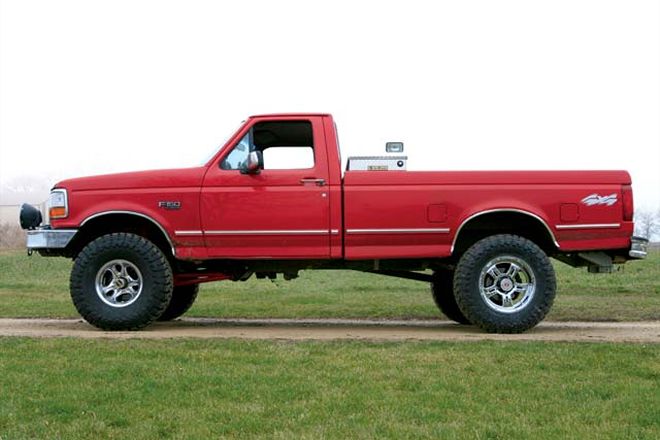
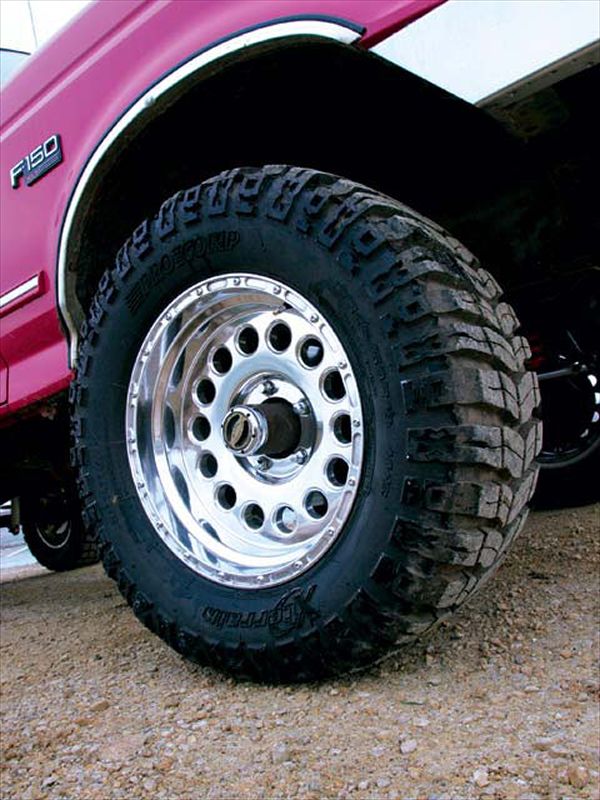 Ken Brubaker
Senior Editor, Four Wheeler
Ken Brubaker
Senior Editor, Four Wheeler
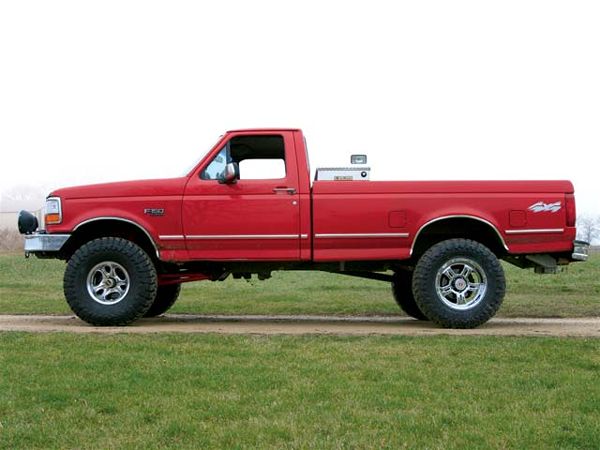
For years, the 15-inch-diameter wheel was the standard for us 'wheelers. It didn't matter whether we were running 31-inch- or 44-inch-diameter tires on our rigs-most of us used 15-inch wheels. Five years ago, the largest wheel diameter advertised in the October issue of Four Wheeler was 17 inches. Most were in the 15- to 16.5-inch range. But times have changed. The Jan. '05 issue of Four Wheeler sported advertising for a number of 18- and 20-inch wheels. Another indicator of the trend towards bigger wheels is seen when looking at the competitors in Top Truck Challenge (TTC). These folks have historically been on the cutting edge of 'wheeling tech, and in 2000, 9 of 10 TTC competitor rigs were equipped with 15-inch wheels. In 2004, the numbers were radically different as seven TTC rigs had 16.5s and only two had 15s. One competitor was running 20s. The OEMs are also jumping into the big wheel trend. Consider that the largest wheel diameter in our 2000 Pickup Truck of the Year competition was 16 inches. In '04, the largest wheel diameter increased to 18 inches, and a couple of rigs were equipped with 17s. Further, OEMs like Dodge and Ford now offer optional 20-inch wheels on some of their trucks.
From showrooms to boulders, bigger wheels are becoming commonplace. But does this new trend help or inhibit our rig's performance? Why would you need a larger wheel? Is the cost of the larger wheels and tires justified? How do the two compare in regards to weight? Could it be that wheel size is ultimately irrelevant in the big picture, or is the 'wheeling public just figuring out something the pioneers knew 150 years ago when they outfitted their wagons with 50-inch wheels?
We wanted to know the answers to these questions, so we tested a few combinations of wheels and tires. We also asked 'wheelers and tire gurus a lot of questions, and we found that discussing wheel size makes some folks as emotional as the Ford vs. Chevy debate (some consider it an abomination).
As you'll soon read, we chose to test 15- and 18-inch-diameter wheels in both 33- and 35-inch-diameter tire sizes. It's a no-brainer as to why we chose the 15s. We chose the 18s because the signs we see in the industry point to this size wheel as being the next big thing (no pun intended). We chose 33- and 35-inch tires because these are popular sizes (and they're the largest we could fit on our test rig). As you will see, tire and wheel width varied. There's not a whole lot we could do about that, as we had to work with what was available at the time testing needed to begin, which was many months before this story was written.
Hopefully, the following data will help you answer the question as to whether larger wheels are bling or king.
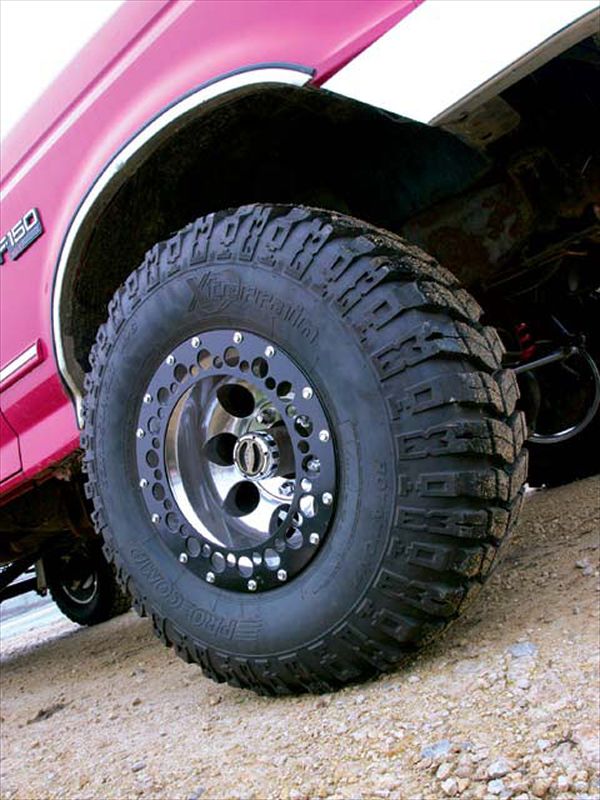
Combination tested: 33x12.50R15 Pro Comp Xterrain w/15x10 Pro Comp 1079
Tire/wheel data: The Xterrain is CAD-designed, with directional lugs and deep lug sipes. The tire features Dualguard polyester body plies that consist of thick two-ply polyester construction. The sidewalls feature a blend of dual sidewall rubber, allowing for maximum puncture resistance with total flexibility when using lower air pressure off-road without excessive heat buildup. The Xterrain also features two layers of opposed-angle steel belting that spans the tread area for maximum puncture resistance. Pro Comp says that this opposed-angle steel also allows the tread to flex under lower air pressure to maximize traction off-road. The 15x10 Pro Comp 1079 aluminum wheel has a fully polished face and is constructed using strength-producing counter-pressure casting technology. The optional Xtreme rings give the wheels a rugged bead-lock look, and simply bolt on.
Tire weight (lb.): 53
Wheel weight (lb.): 26
Combined weight (lb.): 78
Overall tire diameter (in.): 32.6
Approximate street price of 33x12.50R15 Pro Comp Xterrain: $202.99
Approximate street price of 15x10 Pro Comp 1079 w/Xtreme ring: $190.98

Combination tested: 33x13.50R18 Pro Comp Xterrain w/18x9.5 Pro Comp 1059129-0504-comp-03 (IMG_9007)
Tire/wheel data: This is Pro Comp's newest Xterrain. While it shares many of the visual design cues with the 33x12.50R15 Xterrain, it differs in a number of areas. First, it uses a three-ply sidewall instead of the two-ply sides found on other Xterrains. It also incorporates two layers of opposing-angle steel belting, along with a full layer of nylon wrapping in the tread area, for six plies of protection. Further, it uses its own specific rubber compound called Xtreme Traction Compound (XTC). Like Pro Comp's 1079 Xtreme polished wheel, the 1059 is manufactured using counter-pressure casting to produce a strong wheel. With that said, the 1059 has an impressive maximum load carrying capacity of 3,420 pounds.
Tire weight (lb.): 75
Wheel weight (lb.): 30
Combined weight (lb.): 105
Overall tire diameter (in.): 33.6
Approximate street price of 33x13.50R18 Pro Comp Xterrain tire: $349.99
Approximate street price of 18x9.5 Pro Comp 1059 wheel: $168.99
33x12.50R15 @ 35 psi (in.): 9.75
33x12.50R15 @ 16 psi (in.): 11.0
33x12.50R15 tread width increase (% ): 13
33x13.50R18 @ 35 psi (in.): 12.0
33x13.50R18 @ 16 psi (in.): 12.5
33x13.50R18 tread width increase (%): 4
33x12.50R15 @ 35 psi (in.): 7.0
33x12.50R15 @ 16 psi (in.): 6.25
33x13.50R18 @ 35 psi (in.): 6.25
33x13.50R18 @ 16 psi (in.): 5.25
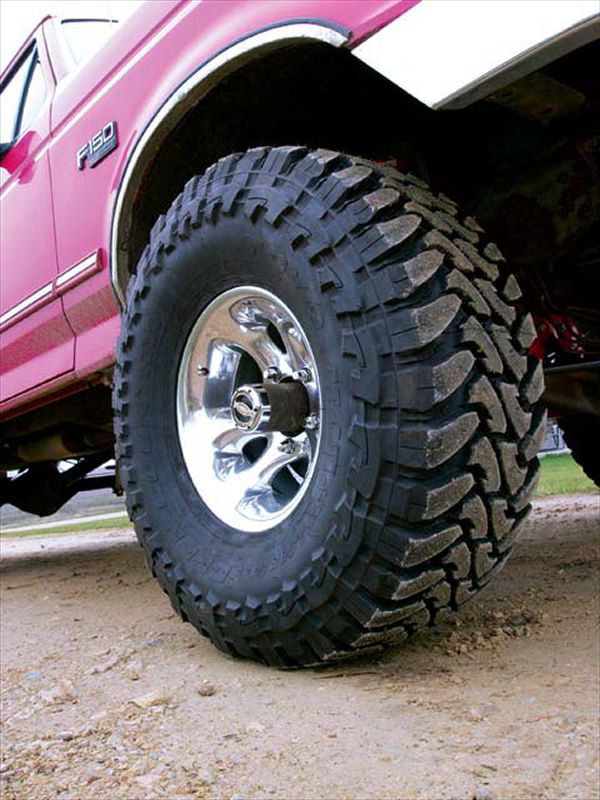
Combination tested: 35x13.50R15 Toyo Open Country M/T with 15x10 Eagle Alloy Series 117
Tire/wheel data: This tire uses a cap/base construction, two wide steel belts, two spiral-wound nylon cap plies, and a high turn-up three-ply polyester casing. The tread design is computer-optimized, the tread elements are shaped and staggered for reduced noise, and the sidewall compound is bruise and abrasion resistant. The one-piece Eagle Alloy wheels are polished.
Tire weight (lb.): 84
Wheel weight (lb.): 25
Combined weight (lb.): 109
Overall tire diameter (in.): 34.8
Approximate street price of 35x13.50R15 Toyo Open Country M/T: $232.99
Approximate street price of 15x10 Eagle Alloy 117: $137.88
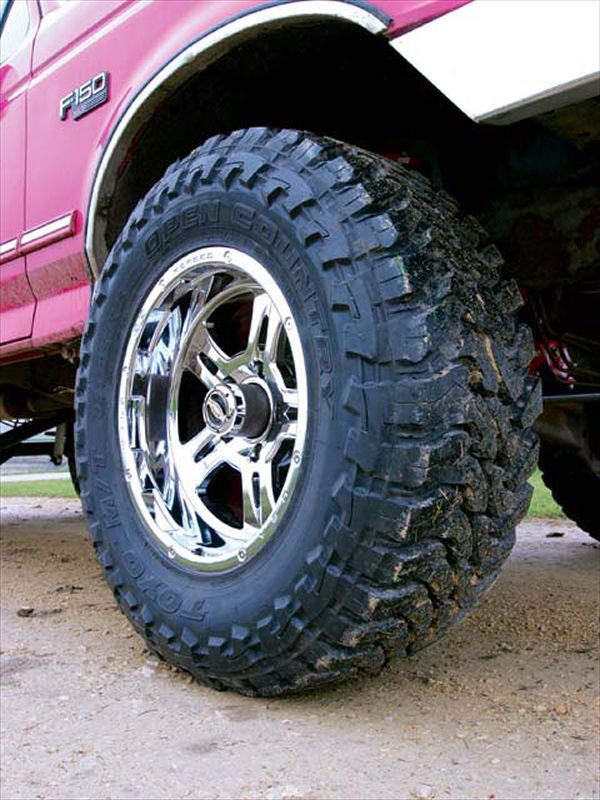
Combination tested: 35x12.50R18 Toyo Open Country M/T with 18x12 Weld Racing Cheyenne 5
Tire/wheel data: Toyo uses the same manufacturing process throughout the entire line of Open Country M/T tires, so the 15-inch tire tech specs apply to the 18-inch tire as well. Like the 15-inch tire, the 18-inch has an aggressive, attack tread design, over-the-shoulder tread, and deep siping in the tread blocks. The Weld Racing Cheyenne 5 wheel is forged from 6061 alloy, which gives it a very impressive 4,000-pound load rating.
Tire weight (lb.): 81
Wheel weight (lb.): 34
Combined weight (lb.): 115
Overall tire diameter (in.): 35
Approximate street price of 35x12.50R18 Toyo Open Country M/T: $348.99
Approximate street price of 18x12 Weld Racing Cheyenne 5: $545
35x13.50R15 @ 35 psi (in.): 10.5
35x13.50R15 @ 16 psi (in.): 10.75
35x13.50R15 tread width increase (%): 2
35x12.50R18 @ 35 psi (in.): 10.5
35x12.50R18 @ 16 psi (in.): 10.75
35x12.50R18 tread width increase (%): 2
35x13.50R15 @ 35 psi (in.): 8.25
35x13.50R15 @ 16 psi (in.): 7.75
35x12.50R18 @ 35 psi (in.): 7.0
35x12.50R18 @ 16 psi (in.): 6.25
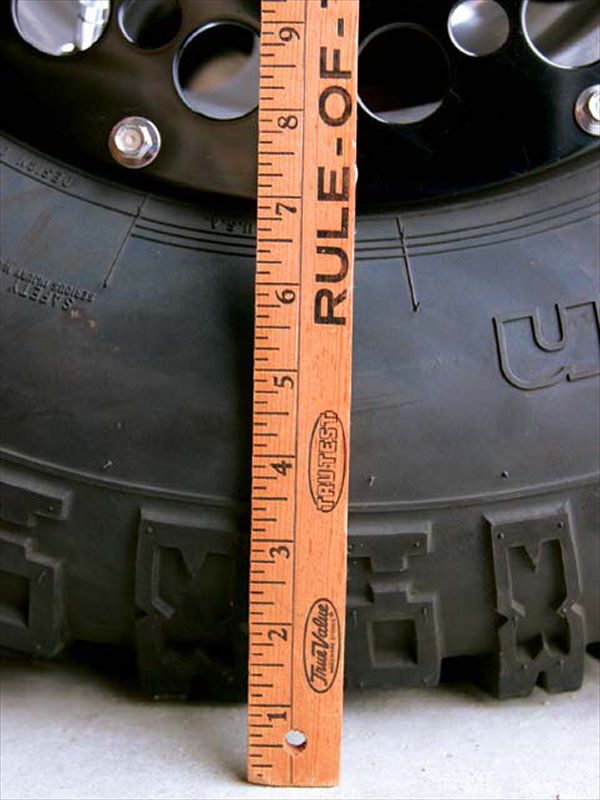
On the street, a shorter sidewall height will definitely improve a truck's handling at speed. We noted a vast improvement in our test truck's overall handling when it was equipped with the two 18-inch wheel/tire combinations (as compared to the 15-inch wheel/tire combinations). The overall ride quality suffered a bit, as the shorter sidewall of the 18s was unable to absorb shock as well as the 15s. This passed more shock to the wheels, but it was in no way uncomfortable. It also forced the suspension to work more and we had to readjust our Rancho RS 9000X shocks to compensate for the lack of sidewall. At highway speed, the truck exhibited less wander and a far quicker reaction to steering inputs when shod with the 18-inch combination. As you can see by the test data, airing down from street pressure to 16 psi cost between 1/2 and 1 inch of sidewall height. This may not seem like much, but in smaller-diameter tires, it means a reduced safety margin between wheel and immovable trail object.
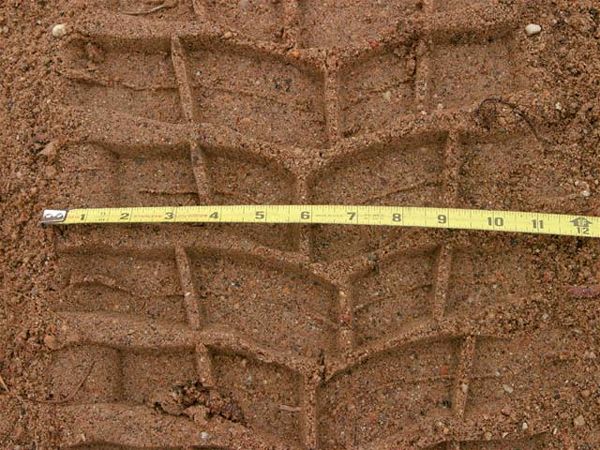
How much a tire flattens out when aired down depends a lot on its construction. Some tires have very soft sidewalls and others are very stiff. With this in mind, our testing showed that both sizes of Toyo tires were equal in the percentage of tread width increase when aired down to 16 psi from street pressure. We used a percentage basis to measure this because the tires were of two different widths. Once again, it's important to note that the 15- and 18-inch Xterrains are manufactured differently, hence the large difference in percentage of tread width increase.
Using the street pricing at the time of this writing, there was a $125.01 difference per tire/wheel between the 33x15 and the 33x18 Pro Comp tire/wheel combinations as tested. If you buy five, this translates to a $625.05 difference. The 35x15 and the 35x18 Toyo tire/wheel combinations showed a $523.12 difference per wheel, but bear in mind that was figured using the 18x12 Weld Cheyenne 5 wheel, which has a street price of $545. Figured using this example, five 35x18s would run you $2,615.60 more than the 35x15s. Once again, it's important to note that these figures represent the specific wheel/tire combinations that we tested, so your actual cost could be radically different depending on the wheel/tire combination you choose. Bottom line: Expect to pay more for larger-diameter wheel/tire combinations.
Jimmy Nylund, one of Four Wheeler's experienced tire testers, notes that "less unsprung weight equals performance in every aspect, and especially so in rotating weight." When compared to a 15-inch tire, an 18-inch tire of the same outside diameter will generally tip the scales at a few pounds lighter. Such is the case with the Toyo tires we tested here, as the 18s weighed 3 pounds less than the 15s. However, this isn't always the case, as the Pro Comp 18-inch tires weighed substantially more than the 15s. The reason for this is that even though the Xterrains share the same name, the two sizes are constructed quite a bit differently (see the tire data on the previous page). Another thing to remember is that it takes more wheel to fill an 18-inch hole than a 15-inch hole, so this will add weight to the 18s, often offsetting the lower tire weight. Interestingly, there was only a 6-pound difference between the 15- and 18-inch Toyo wheel/tire combinations.
In rockcrawling applications, larger-diameter wheels (18-inch and up) are currently found on about 10 percent of all machines. The debate over larger wheels is still being fought on the boulders of rockcrawling competitions like UROC and ProRock. Many drivers use 17-inch wheels, but entertain the thought of larger wheels as availability improves. Troy Myer, driver of the Wasp rock buggy, is one of the drivers who would consider defecting from his 17-inch-diameter wheels. He said that one of the benefits he found by switching from 15- to 17-inch wheels was that it alleviated wheelhop issues due to the shorter sidewall storing less energy. Rockcrawlers praise shorter sidewalls for their reduced sidewall roll when off-camber, but debate several points including the shorter sidewall's ability to get pinched between wheel and rock after going airborne with an aired-down tire, as well as the increased probability of peeling a tire from the wheel.
As with many four-wheel-drive modifications, there is no right or wrong answer to the 15- versus 18-inch question. The answer lies in how you use your rig and your own personal preference.
Point and laugh at them if you want, but there's a place in our world for 18-inch wheels. Look, they allow you to bolt on a larger set of brakes, which is something almost every modified rig needs; they improve handling while unladen, laden or while towing; and if you're into bling, they're the hottest new look. On the other hand, 15s are much less expensive; they're easier to buy in the middle-of-nowhere; and they offer arguably better overall off-road performance and a smoother ride compared to 18s. What does our staff run? Half of us run 18s and the other half run 15s.